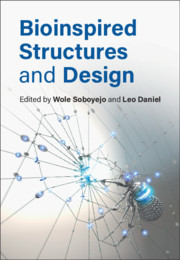Book contents
- Bioinspired Structures and Design
- Bioinspired Structures and Design
- Copyright page
- Contents
- Contributors
- Preface
- Part I Materials
- 1 Bioinspired and Biomimetic Design of Multilayered and Multiscale Structures
- 2 Human Cortical Bone as a Structural Material
- 3 Bioinspired Design of Multilayered Composites
- 4 Bamboo-Inspired Materials and Structures
- Part II Structures
- Part III Natural Phenomena
- Index
- References
1 - Bioinspired and Biomimetic Design of Multilayered and Multiscale Structures
from Part I - Materials
Published online by Cambridge University Press: 28 August 2020
- Bioinspired Structures and Design
- Bioinspired Structures and Design
- Copyright page
- Contents
- Contributors
- Preface
- Part I Materials
- 1 Bioinspired and Biomimetic Design of Multilayered and Multiscale Structures
- 2 Human Cortical Bone as a Structural Material
- 3 Bioinspired Design of Multilayered Composites
- 4 Bamboo-Inspired Materials and Structures
- Part II Structures
- Part III Natural Phenomena
- Index
- References
Summary
In recent years, there has been significant interest in the fields of bioinspired design and biomimetics [1]. Bioinspired design involves the use of scientific and engineering principles in the design of engineering components and structures that are inspired by biological systems. In contrast, biomimetics involves the design of engineering components and structures that copy biological systems. Hence, airfoils and aircraft wings are examples of bioinspired design that are inspired by bird flight but guided by the principles of lift and drag from aerodynamics. In contrast, the early idea of an airplane with flapping wings is an example of biomimetics, which is based on the simple idea of copying nature without thinking carefully about the underlying scientific principles that enable such natural systems to function in the way that they do.
- Type
- Chapter
- Information
- Bioinspired Structures and Design , pp. 3 - 19Publisher: Cambridge University PressPrint publication year: 2020
References
- 1
- Cited by



